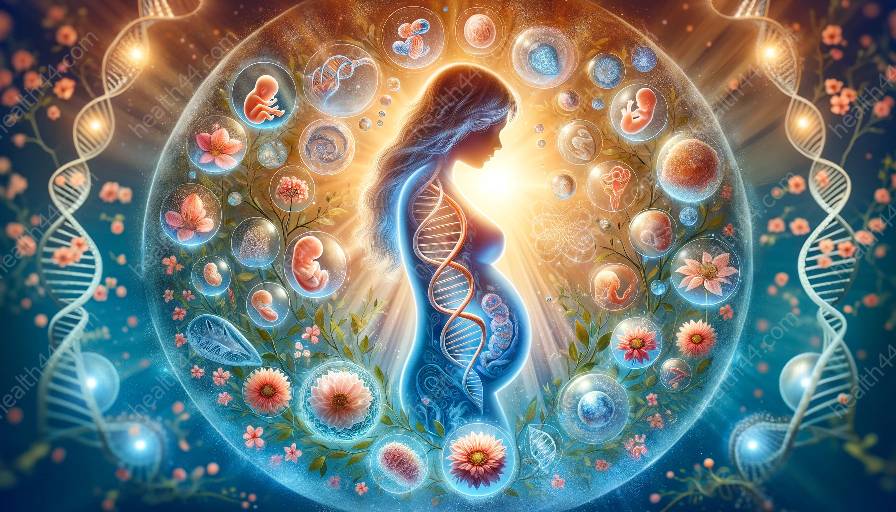The process of oxygen exchange and gas transport in fetal circulation is a fascinating aspect of human development. The journey of oxygen as it enters and navigates through the fetal circulatory system is a critical process that ensures the health and growth of the developing fetus. Understanding the intricacies of oxygen exchange and gas transport in fetal circulation sheds light on the remarkable adaptions that allow the fetus to thrive in the unique environment of the womb.
Fetal Circulation Overview
Before delving into the specifics of oxygen exchange, it is essential to grasp the basics of fetal circulation. Unlike the postnatal circulation, the fetal circulatory system possesses unique structures and pathways which facilitate the exchange of oxygen and nutrients between the mother and the developing fetus.
During fetal development, the placenta plays a crucial role as the interface between the maternal and fetal circulation. The placenta allows for the transfer of oxygen, nutrients, and waste products, serving as a bridge for gas exchange and essential substance transport between the mother and the fetus.
The Role of the Placenta
The intricate network of blood vessels within the placenta is where the magic of oxygen exchange and gas transport in fetal circulation occurs. The fetal circulation is characterized by the presence of two shunts, the ductus venosus and the foramen ovale, which direct the blood flow to bypass the non-functional fetal lungs.
The umbilical vein carries oxygenated blood from the placenta to the fetus, and a portion of this blood is diverted via the ductus venosus directly to the inferior vena cava, thereby avoiding the hepatic circulation. This ensures that the developing fetus receives a high concentration of oxygenated blood essential for its growth and development.
Meanwhile, the foramen ovale provides a pathway for oxygenated blood entering the right atrium of the heart to be shunted to the left atrium, thereby bypassing the pulmonary circulation. This mechanism is essential for diverting the oxygen-rich blood directly to the systemic circulation, enabling efficient delivery of oxygen throughout the fetal body.
Oxygen Exchange in the Placenta
Within the placenta, the process of oxygen exchange occurs through the intricate network of capillaries. Deoxygenated blood from the fetus is transported through the umbilical arteries to the placenta, where it comes into close contact with the maternal blood in the intervillous spaces.
As the maternal and fetal blood flow through their respective capillaries, the exchange of oxygen and carbon dioxide takes place by diffusion, driven by concentration gradients. This enables the transfer of oxygen from the maternal blood to the fetal blood, ensuring a continuous supply of oxygen essential for the metabolic needs of the growing fetus.
Gas Transport in Fetal Circulation
As oxygen enters the fetal circulation via the placenta, it embarks on a journey through the developing fetal body. The oxygenated blood travels from the placenta through the umbilical vein into the inferior vena cava, where it is then directed to the right atrium of the heart. From the right atrium, the blood passes through the foramen ovale, bypassing the pulmonary circulation, and enters the left atrium.
From the left atrium, the oxygenated blood moves into the left ventricle and then to the aorta, which distributes the oxygen-rich blood to the systemic circulation, supplying the fetal tissues with the vital oxygen necessary for growth and development.
Challenges in Fetal Gas Transport
While the fetal circulation effectively facilitates oxygen exchange and gas transport, several challenges need to be navigated to ensure optimal oxygenation of the developing fetus. Any compromise in the placental function or the patency of the fetal shunts can lead to inadequate oxygen supply, impacting the growth and well-being of the fetus.
In instances where the fetal circulation faces challenges, medical intervention may be necessary to support the exchange of oxygen and gas transport. Understanding the delicate balance required for effective oxygen exchange and gas transport in fetal circulation is crucial for providing appropriate care for high-risk pregnancies.
Conclusion
Oxygen exchange and gas transport in fetal circulation are integral processes that ensure the optimal development of the fetus. The journey of oxygen from the placenta to the fetal tissues is orchestrated through a series of remarkable adaptions within the fetal circulation. Understanding these processes not only sheds light on the marvels of human development but also provides insights for medical professionals in managing fetal health and well-being.


